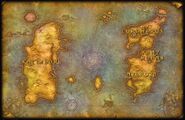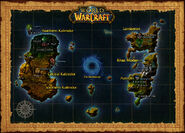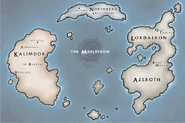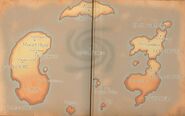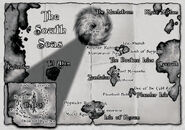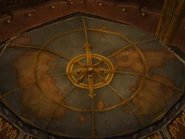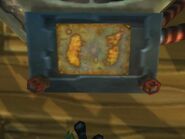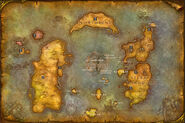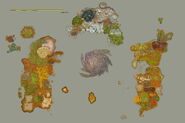- For other uses, see Azeroth.
| Level 1 - 90 | |
|---|---|
 | |
| Ruler |
|
| Location | Great Dark Beyond |
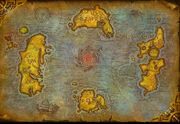
Azeroth with Pandaria from Beta build 15739.
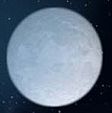
The moon known as White Lady.
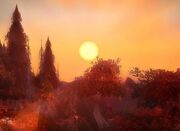
Azeroth's sun. Commonly called the sun.
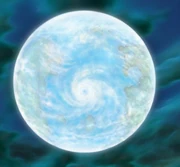
Azeroth as seen from the Black Temple.
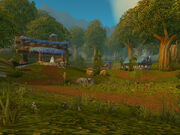
Azeroth has beautiful farmland.
Azeroth is the name of the world in which the majority of the Warcraft series is set. The world of Azeroth is the birthplace of many races, most notable being elves (night elves, high elves, and blood elves), humans, dwarves, tauren, goblins, trolls, gnomes, pandarens and dragons. At its birth, Azeroth was blessed by the titans. One day, the demonic armies of the Burning Legion came and shattered the peace and led the night elves to sunder their world. Gradually, races were dragged to Azeroth (such as the orcs, draenei, and ogres), others evolved, and others were brought up from the dust itself. The peoples of Azeroth have fought brutally against the demons and their servants, and much blood was and is still being shed. After the Third War, three major powers emerged: the Scourge, Horde, and Alliance. Other major powers include the naga, qiraji, and Scarlet Crusade. Although ravaged by conflict, somehow through trickery, betrayal, and sheer blood, Azeroth has survived the Burning Legion four times. However, Azeroth is still torn by conflict, hate, and war.
Geographical features[]
The world of Azeroth is comprised of four major continents, with a number of smaller islands scattered about them. Northrend is located in the north, Kalimdor in the west, the Eastern Kingdoms (aka eastern continents)[1] in the east, and Pandaria in the south. The Eastern Kingdoms are made up out of two large landmasses - the southern one includes Azeroth and Khaz Modan,[2] and the northern land of Lordaeron.[3] At one time, all of the three major continents (excepting Pandaria) were part of one large continent (known as Kalimdor), with a large magic lake known as the Well of Eternity in the center. When the well exploded at the conclusion of the War of the Ancients, this continent was shattered, leaving behind the continents and islands that exist today. The Forbidding Sea is the expanse of water to the east of the Eastern Kingdoms and the Veiled Sea sits west of Kalimdor. Between the continents lies the Great Sea, while at its center lies the Maelstrom — a massive chaotic whirlpool over the area where the Well of Eternity once stood. It's believed that a part of the Well still exists in the Rift at the bottom of the vortex. It has been active since the Great Sundering ten thousand years ago and still there is no foreseeable natural end to its existence.
The Eastern Kingdoms are made up of several continents including the southern continents (Azeroth and Khaz Modan),[2] and the northern continent of Lordaeron.[3]
The world of Azeroth also may have land located at the other side, beyond the Veiled Sea to the west of Kalimdor, and beyond the Forbidding Sea to the east of the Eastern Kingdoms. No one is sure or has knowledge of what kind of creatures, lands, cultures, life, and sentient being lives in the other side of Azeroth. It is clear though that it is very dangerous.
"A handful of ships have ventured from Kalimdor away from the Maelstrom — to the north, west, and south. None have yet returned."[4]
Azeroth also has two moons, the White Lady and Blue Child.
History[]
- Main article: Timeline
For much of Azeroth's prehistory, the Old Gods ruled Azeroth along with their Elemental Lieutenants. Azeroth attracted the attention of the wandering titans, who fought the Old Gods in a war of ordering. With the help of their constructs (the antecedents of dwarves, gnomes, vrykul, and giants), the titans allowed life to flourish on Azeroth. Satisfied, the Makers built hidden cities for their construct creations and created the Great Aspects to guard the planet before leaving on their cosmic journey.
Pandaria was also created at some point, but quickly fell out of the history of most sentient races, due to its magical shrouding mists. It developed a parallel history, largely out of the view of most historians.
The trolls are presumed to be Azeroth's first sentient race, not including the titan constructs who would later suffer the Curse of Flesh. From Zandalar, they spread across Kalimdor and formed great empires, most notably the Gurubashi and Amani. Later, the Azj'Aqir empire rose in the west, forcing the trolls to better defend their major holdings. With pressure from their trollish enemies, the empire of the aqir collapsed and split into the qiraji and the nerubian kingdoms.
Around this time, the elves appeared in Kalimdor. Using the potent magics of the Well of Eternity (a legacy of the titans), the elves broke troll influence in many regions and established a magocratic empire. At the height of kaldorei power, however, the Burning Legion invaded Azeroth, inciting the War of the Ancients. The night elves were forced to destroy the Well, which caused a Great Sundering that split the ancient supercontinent of Kalimdor apart — creating several continents, Northrend, the Eastern Kingdoms (continents of Azeroth, Khaz Modan, and Lordaeron), and "Kalimdor".
Just before the Great Sundering, the last pandaren Emperor was made aware of the impending disaster and found a way to protect Pandaria from the destruction. He made a pact with unknown forces to shroud his land within an impenetrable mist for ten thousand years.[5]
Following the war there was a schism among the elves. The night elves started druidism with Malfurion Stormrage as the first Night Elf Druid; the high elves refused to give up arcane magic. These high elves were banished from Kalimdor and settled in the north of Lordaeron, establishing the mighty kingdom of Quel'Thalas. The Amani Empire was still a strong force here, and the two cultures soon clashed in what became known as the Troll Wars. With support from the young race of humanity, the high elves broke and scattered what remained of the Amani empire.
Thousands of years later, the Burning Legion attempted to destroy Azeroth once more, this time indirectly. Sargeras forced the once peaceful orcs and ogres of Draenor into Azeroth.[6] The extended conflict with these alien invaders became known as the First and Second Wars, during which time the Horde established strongholds in Blackrock, Alterac Valley, Zul'Dare, and the Swamp of Sorrows. The mighty Horde was defeated by an alliance of high elves, dwarves, and humans. Feeling the effects of their demonic bloodrage dissipate as they languished in internment camps, the orcs were able to remember their peaceful, shamanic roots. Sensing this change, Thrall of the Frostwolf clan set about establishing a new Horde.
Angered by the Horde's failure, the Burning Legion prepared for yet another invasion, the culmination of their efforts, on both continents. In the east, the Legion's Lich King pawn set loose a plague of undeath on the human kingdom of Lordaeron that the Legion so despised. This undead Scourge quickly crippled the northern powers, demoralizing the people of the Eastern Kingdoms in preparation for a Legion offensive. Lured to north by the Lich King, Prince Arthas of Lordaeron became his death knight pawn and the instrument of his liberation from the Legion's grasp. The Scourge under Arthas scattered the Knights of the Silver Hand, obliterated Lordaeron and broke the power of the Sunwell in Quel'Thalas.
In the West, the demons and their satyr allies made a more direct assault on their old kaldorei enemies. In desperation, the elves turned to Illidan, a demon hunter from the War of the Ancients who had violated druidic law and had been imprisoned for ten thousand years. During the course of the conflict, Illidan was persuaded by the insidious Arthas to attack the demon known as Tichondrius and drink from the Skull of Gul'dan (a small part in the Lich King's greater scheme to emancipate himself from his Legion jailers).
Through the machinations of Medivh, Last Guardian of Tirisfal, leaders of the New Horde and the Alliance were drawn to Kalimdor. There they joined with the night elves to thwart the Legion advance into Hyjal, where the World Tree was vulnerable to demonic attack. While in Kalimdor, Thrall's people forged powerful alliances with the native tauren and the Darkspear exiles.
Concerned with the separatist Scourge, Kil'jaeden solicited the half-demonic Illidan into destroying the source of the Lich King's power. With the aid of his naga allies, who he had recalled from the Maelstrom, he succeeded in breaking at least some of the Lich King's power. Hounded by his night elf jailers and the seething blood elves, Illidan was unable to complete his task. Suffering under the effects of magical withdrawal, the blood elves were persuaded to enter into the ranks of the Illidari. With their help, Illidan toppled the regime of Magtheridon to become the new ruler of Outland.
The weakening of the Frozen Throne allowed some of the Scourge to regain their free will. Under the Banshee Queen Sylvanas Windrunner, these Forsaken managed to force the Legion-controlled undead from the ruins of Lordaeron and establish a stronghold beneath its streets. Arthas, meanwhile, fought a desperate battle in Northrend to save his master from the newly empowered lord of Outland, who under increasing threats from Kil'jaeden had taken up his quest to destroy the Lich King once more. Illidan failed and retreated to Outland, and Arthas was merged with the malicious spirit of the Lich King.
Following the Third War, the political landscape of Azeroth changed greatly. The night elves joined the Alliance, and the Forsaken joined the New Horde. The remaining citizens of Lordaeron, broken by the Scourge, formed new regimes: the xenophobic and zealous Scarlet Crusade and the compassionate Argent Dawn. The orcish nation of Durotar was established in Kalimdor, as was human colony of Theramore. With the armies of the Horde and the Alliance decimated by the Third War, or occupied with the new conflict in Outland, the defense of their borders became the responsibility of small bands of heroes and adventurers.
Native sapient races[]
|
Template:Col-6 Template:Col-6 Template:Col-6
Template:Col-6
Template:Col-6 |
Resident aliens[]
- A large ogre population is present as a result of the Second War.
- The orcs have established their own nation, Durotar, in Central Kalimdor.
- Large numbers of worgen are also present on Azeroth for a variety of reasons, typically arcane experimentation.
- Demons are also a prominent non-native species. Most have either been summoned by warlocks or came here during the Third War, and stayed.
- Although they were among the first denizens in Azeroth, the Old Gods seems to have appeared from elsewhere. Where they came from, however, is unknown.
Origin of the name[]
The term Azeroth is a human word and is derived from the term used for the ancient primitive-humans that lived on the world pre-sundering, the Azotha.[7]
It is said that when the Arathi brought the scattered human tribes together as the empire of Arathor, they named the land as a whole in homage to their ancient ancestors: Azeroth.[7] It is unclear whether they named the world or named the continent.
Strangely, the term was in use during the War of the Ancients[8] by the night elves, which raises further questions about its etymology and origins. As confirmed, it apparently was from a dialect of Common (adapted from the term Azotha), but why the night elves would use it is unclear.
Speculation on the name origin[]
This article or section includes speculation, observations or opinions possibly supported by lore or by Blizzard officials. It should not be taken as representing official lore.
|
- Alternately, the use of the word in the War of the Ancients trilogy could be considered a continuity error, although other sources imply that the world was called Azeroth at the time as well.
- It is also a possibility that Azeroth being named after the Azotha and possibly the Azotha themselves are simply not considered canon lore by Chris Metzen like Finall Goldensword as they are not referenced outside of the RPG.
- It is also possible that the Night Elves did not use the term Azeroth, and that rather for the benefit of the reader the Night Elf world was translated in the novel and is not a continuity error.
Travel[]
This article or section includes speculation, observations or opinions possibly supported by lore or by Blizzard officials. It should not be taken as representing official lore.
|
- A peculiar feature of travel between continents on Azeroth is the tendency for major routes to use the air and water routes traveling east to the Eastern Kingdoms or back west even though all these routes must pass by the Maelstrom. For some reason, very few routes exist across the Forbidding Sea between the west coast of Kalimdor and the east coast of the Eastern Kingdoms. This might be explainable due to the eastern coasts of the Eastern Kingdoms being fairly rugged and mountainous with few major settlements, but the western coasts of Kalimdor seem mostly accessible.
Also, the expanse of the Forbidding Sea could be up to twice that of the waters between the continents on the Maelstrom side. Perhaps, despite the lack of the Maelstrom, the waters of the Forbidding Sea are a bit too vast, less charted, and more harsh. Despite the troll town in Eastern Hinterlands and the Zoram Strand being an ideal Horde route from eastern Lordearon, but the PCs are more prone to travel across the Great Sea. Until some intrepid sailors collect their reports, we may never know.
Media[]
Maps of Azeroth[]
Fan art[]
References[]
- ↑ Lands of Conflict, pg. 11
- ↑ 2.0 2.1 Lands of Conflict, pg. 89
- ↑ 3.0 3.1 Lands of Conflict, pg. 85
- ↑ Warcraft: The Roleplaying Game, pg. 213
- ↑ Meet the Pandaren. Official Mists of Pandaria site (US). Retrieved on 2012-08-13.
Meet the Pandaren. Official Mists of Pandaria site (EU). Retrieved on 2012-08-13. - ↑ Golden, Christie. "?", Rise of the Horde, ?. ISBN 978-0-7434-7138-1. “?”
- ↑ 7.0 7.1 Lands of Conflict, pg. 18
- ↑ The Sundering, pg. ??
External links[]
- Lore
Template:Azeroth
Template:Warcraft Universe
da:Azeroth de:Azeroth es:Azeroth (Mundo) fr:Azeroth (Monde)

